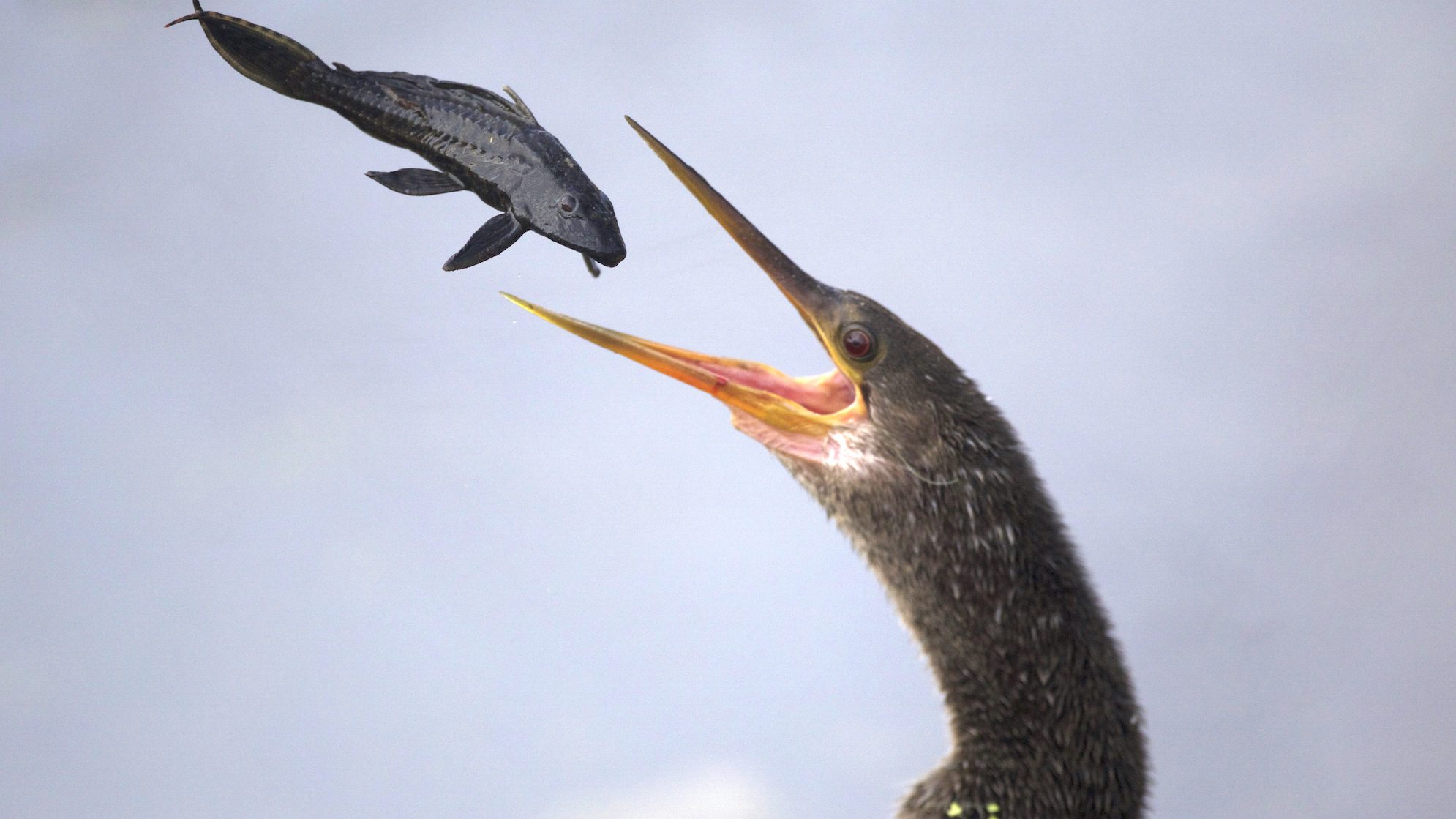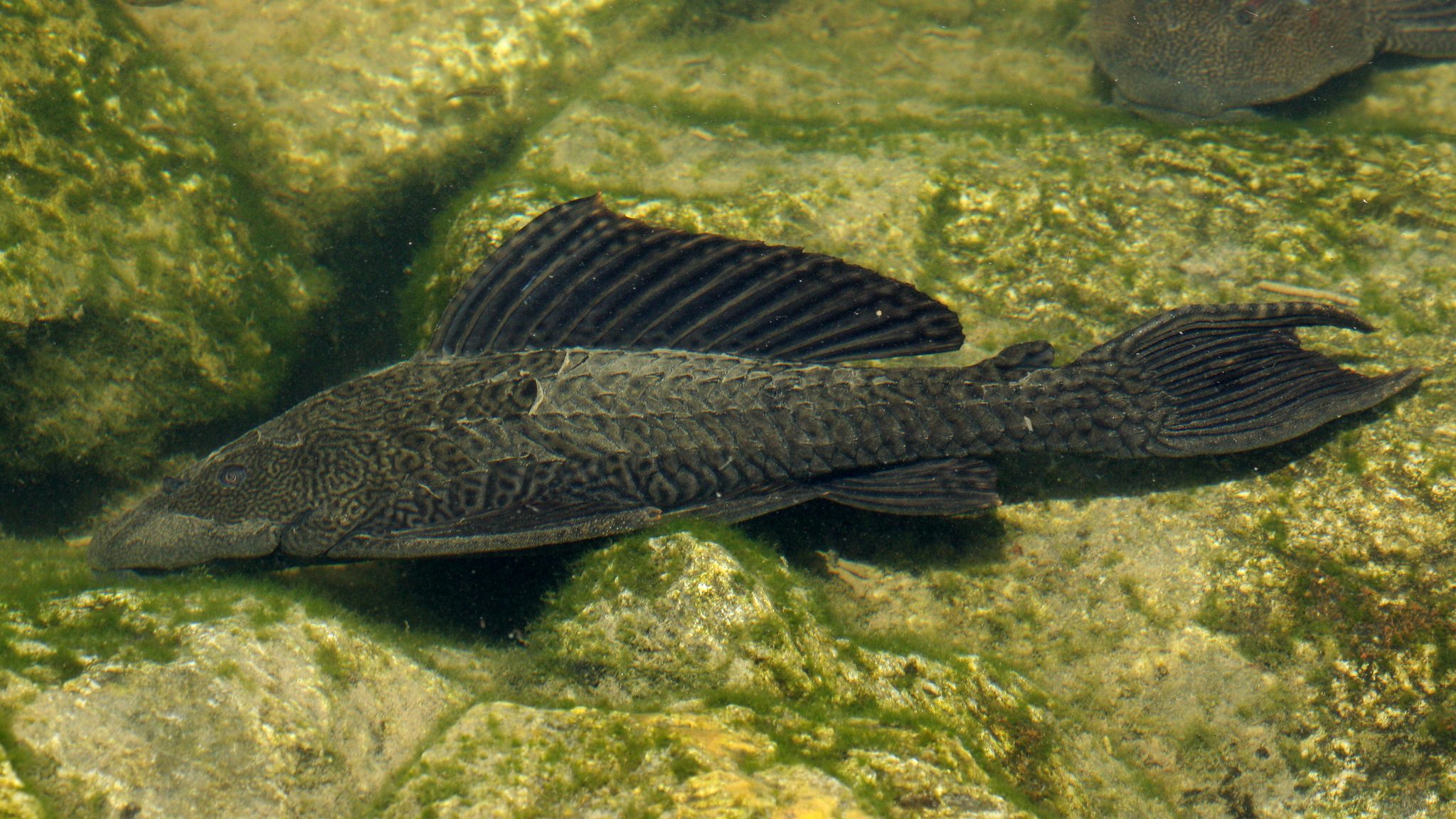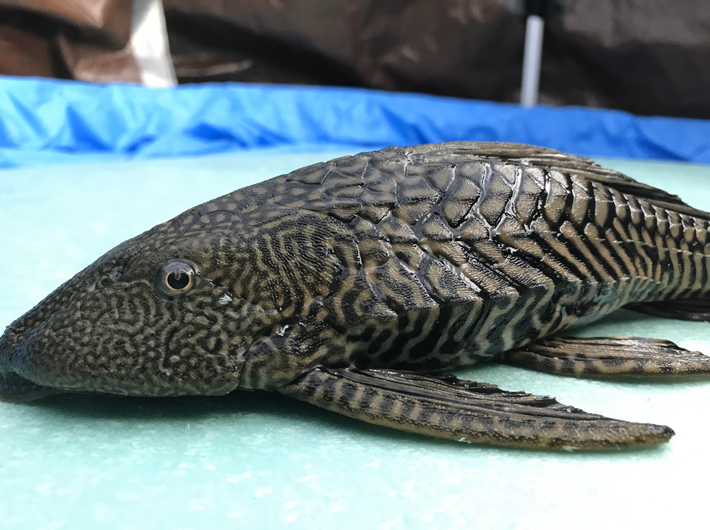Neotropical armoured catfish – also frequently called “plecos” – are not often thought of as fish that can move around on land. But they can and they do so surprisingly well. The way they move is so unusual that researchers had to invent a new word to describe it: reffling.
“It was so unlike any form of terrestrial locomotion seen in any animal,” says Noah Bressman, lead author of a new paper describing the behavior in the journal Ichthyology and Herpetology. “We needed to make a new word.”
Bressman, now an assistant professor of physiology at Salisbury University, is my go-to expert for fishes that can move on land. He has published on the very strange behaviors of walking catfish, including their habit of emerging from drains to hunt earthworms in Florida parking lots. He described how snakeheads can move over a variety of surfaces. While studying other amphibious fishes, he came to describe the locomotion of plecos.
This research began almost by accident. Bressman had utilized crowdsourcing to gather incidents of walking catfish behavior in Florida. Two citizen scientists sent him reports of armoured catfish, which he thought might be errors. But he filed the reports for future reference.
In a separate incident, officials approached him after finding a dead catfish outside his walking catfish research facility. They thought he had allowed one of his highly invasive research subjects to escape. Who let the catfish out?
“It wasn’t one of my walking catfish,” says Bressman. “It was an armoured catfish, 50 feet from the nearest pond. It also got me thinking, and I conceived of a research project to see if these catfish could locomote terrestrially.”

Pets Gone Wild
You are probably familiar with these catfish, commonly called plecos. Fish enthusiasts often keep them to clear algae from their tanks. If you’ve ever seen a sucker-mouthed catfish clinging to the glass walls of your friend’s aquarium, you know the pleco.
Unfortunately, irresponsible aquarium keepers often dump their tanks. This has led to invasive fish around North America, particularly in warm-water environments. Two species of neotropical suckermouth catfish are now abundant and widespread in Florida. They are also found in Arizona, Texas, North Carolina and pretty much anywhere the water stays warm enough year round. They live by scraping algae off rocks and other hard surfaces.
“They burrow into riverbanks, causing erosion,” says Bressman. “They churn up the river bottom, reducing water visibility. There are even reports that they stress out wintering manatees, because they try to eat the algae off the big mammals.”
They are also a hardy species, able to breathe in low-oxygen environments and protected by armor. That armor, though, is also somewhat inflexible, which could lead one to believe they couldn’t move on land. “Thick armor is known to reduce flexibility and maneuverability in other fishes,” the journal article states.
But the pleco has other tricks up its, umm, fins. And tail. Welcome the weird world of reffling.
Reffle Like a Catfish
Bressman began poring through old, obscure journals in search of references to terrestrial locomotion in neotropical armoured catfish. The suckermouth armoured catfish are native to Central and South America. Their family, Loricariidae, is extraordinarily diverse, with more than 920 described species. Bressman found a catfish species, in another taxonomic family, that could climb up waterfalls using inchworm-like movements.
He also found passing references to terrestrial locomotion of the species now living in Florida, often in German journals from the 1800s and early 1900s.
“It was often mentioned in passing that these fish could walk, and that was it,” says Bressman. “There was no elaboration. There was never enough detail to figure anything out.”
So Bressman decided to test pleco locomotion capacity for himself. After gaining the necessary research permission, he placed neotropical armoured catfish in his arena built for filming fish on land. Yes, you read that right. Bressman has a walking fish arena.
And the plecos can move on land. They moved in bursts of 1 meter per second, which translates to about 2.3 miles per hour. That would be a pretty slow human walking pace. But for fish it’s downright speedy.
But here things get weirder. Because plecos have that armor, they can’t move like a more flexible species, say a walking catfish or a snakehead. To move, they fling their tail more sharply to one side than the other. And this does not seem a method really for getting, well, anywhere.
Bressman offers the comparison of canoeing. Imagine if you just canoed on one side of your watercraft. You’d go in circles. This also happens if one canoeist is paddling much more forcefully than her partner. The same is true if a tail moves more strongly to one side. But not with the pleco.
While it just looks like a tail flapping about, the whole process is quite intricate.
For small plecos, the tail never touches the ground. For larger plecos, it appears the lowest portion of the tail slides across the ground. After the tail flings forward on one side of the body, it moves more slowly and with not as much amplitude toward the other side, as the mouth touches the ground. At the same time, the catfish’s pectoral and pelvic fins on that side of the body protract while in contact with the ground, rotating the body forward around the mouth, before the tail flings back to the other side as the mouth lifts up. Then the whole process repeats.
If that sounds a bit complicated, Bressman offers an analogy. The flinging of the tail forward through inertia (rather than using the ground) is similar to how a kid pumps their legs on a swing set to get higher and higher.
Clearly, the pleco was flinging itself forward in a coordinated manner. Or, as the researched dubbed it, the catfish was reffling.
A side note here on creating a new term. Bressman’s first choice for a term was flooping, but his advisor nixed that. He had to make sure his term was not already in use. “There are a lot of words we came up with that were actually slang terms with really unfortunate definitions,” he says.
So reffling it is.
But why does reffling matter?

Reffling to New Waters?
Bressman says that neotropical armoured catfish, in their native habitat, often live in environments prone to flooding and drying cycles. He hypothesizes that the catfish may have evolved this behavior to move when a wetland dries up.
However, the plecos don’t appear to go on walkabout like that other Florida invasive, the walking catfish. Walking catfish are frequently observed moving about on roads, lawns and parking lots to go hunting and probably to move from one waterway to another.
Plecos don’t appear to do this. While they can move quickly in short bursts, the research suggests their endurance declines over time, much as a marathon runner doesn’t run as fast as a sprinter. So if they aren’t likely to exhibit this behavior on their own, is there much to be concerned with from an invasive species perspective?

The paper argues that reffling is an important behavior for invasive species managers to consider. As anyone who has looked beneath the watery surface of the Everglades knows, pleco catfish are readily observed in shallow water, feeding on algae-covered rocks. This makes them easy prey for herons, ospreys and other predators.
However, once the predatory bird carries them off to be eaten, they find a fish covered in armor and spines. “You see these birds struggling to eat the fish,” says Bressman. “The bird often gives up, and drops the pleco. It can be a good distance away from where they caught it.”
Deposited on land, the pleco could move to a new water body.
A similar scenario could happen to humans. Bressman notes that many anglers know armoured catfish are invasive, so if they catch one, they might throw the fish up onto the bank. They think they are doing something helpful. It should be noted that this angling behavior – tossing a fish on a bank – is not humane, at best creates a stinking mess and is never the best course of action. In the case of plecos, it could be another way to help them spread. Instead of stopping an invasive, the angler is enabling them to move to a new water body.
Plecos can survive out of water for up to 20 hours, and their armor reduces water loss. A dropped fish – whether by bird or human – has time to reach a new waterway. For a species already invasive, that should be considered as a potential means of spreading.
“These catfish are limited in where they can spread by water temperature. They can’t survive in cold waters, but more waters could be available by climate change,” says Bressman. “This species is already found in the warmer U.S. states. They have been spread in Europe and India. They are widespread in the aquarium trade. People should not be potentially contributing to this spread by throwing plecos on the bank.”




Thank you for an excellent article! I love learned about new catfish that walk!!